Tested: 2003 Porsche Cayenne Turbo Did It All
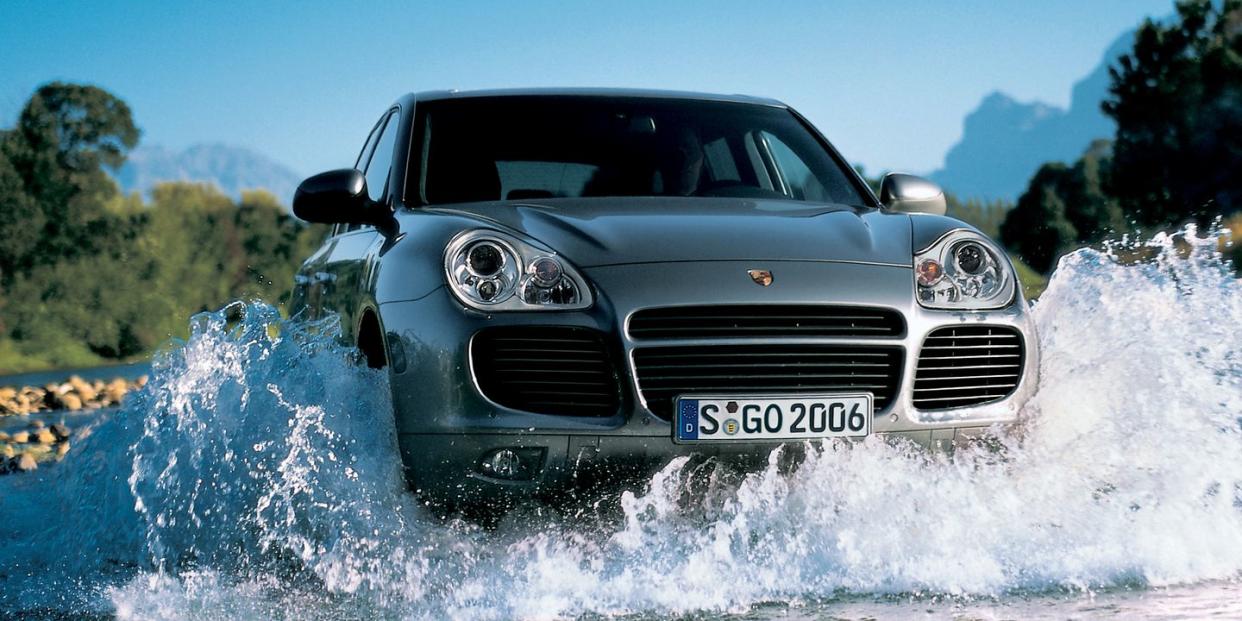
From the August 2003 issue of Car and Driver.
We like numbers. Numbers are our friends. Numbers sing arias of irrefutable fact that soar above murky choruses of subjectivity, spin, and slant. Numbers can baby-sit our kids anytime.
So wrap your head around this number: 5724—as in pounds, as in curb weight for the Porsche Cayenne Turbo. This is almost exactly the weight of a GMC Yukon XL—a perimeter-frame four-by-four truck with a 12,000-pound towing capacity and 17.6 more inches of wheelbase than the unit-bodied Cayenne Turbo. This number—the weight of our test vehicle with all the fluids onboard—is approximately one Harley-Davidson Sportster more than we expected the Cayenne Turbo to weigh, based on the company's specifications. Around the office, many a jaw has gone oafishly slack at this imposing avoirdupois—and the jaw-slacking bar is set pretty high here.
Our scales, meanwhile, have quit to find easier work in the piano-moving business.
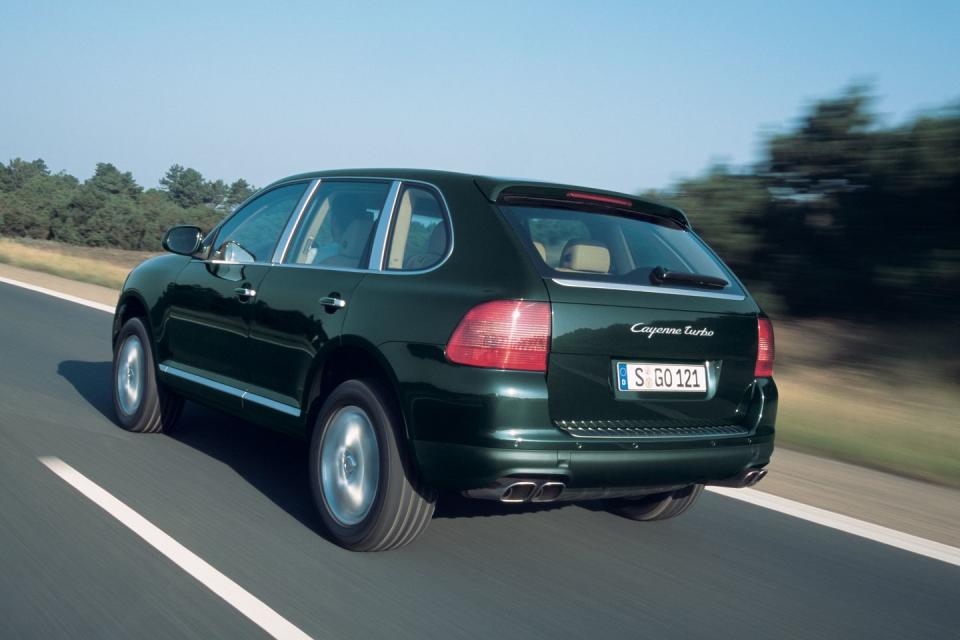
This number goes to the heart of the Cayenne conundrum: Why, when a statistically insignificant number of SUV owners ever venture off-road, would Porsche—a company that year in, year out builds the best sports cars in the world—burden the Cayenne with such silly amounts of heavy, hillock-humping capacity? Twenty-two-inch fording depth? More than 10 inches of ground clearance, courtesy of ride-height-adjustable air springs? A torque-multiplying low-range gear ratio and locking center and rear differentials?
This is not to quarrel with Porsche CEO Wendelin Wiedeking's decision, in 1998, to stick a Porsche-badged snout in the SUV trough. Nor is it to diminish, exactly, the Cayenne T's off-road abilities, which include leaping over felled trees in a single bound (it has an approach angle of 32.4 degrees and a departure angle of 27.3 degrees). But after 600 miles of mixed driving in the Cayenne Turbo—from Vanishing Point-style transits of upper Lower Michigan to plowing through dirty, smelly filth holes (the restaurants of upper Lower)—we have reached the conclusion that rather than digitally morph a Range Rover with a 911 Turbo, Porsche has created a vehicle that feels like a superb all-wheel-drive tourer with an elephant on its back.
Is it fast? Is Wiedeking hard to spell? The vehicle's quickness and speed (we recorded a zero to 60 mph time of 5.0 seconds and a quarter-mile pass of 13.5 seconds) are stunning, but here numbers fail us; it's not the velocity per se but the giddy sensation of enormous mass being manhandled by oceanic force, like a tugboat thrown on the beach by a tsunami. The Cayenne's reactor is a twin-turbo, quad-cam 4.5-liter V-8 with dry-sump lubrication and other fancy plumbing to keep it oily and cool in extreme off-roading. Thanks to its VarioCam intake-valve timing, the motor produces peak torque of 457 lb-ft between 2250 and 4750 rpm and a nice fat 450 horsepower at 6000 rpm. The soundtrack to all of this is a futuristic warbling of metallic timbre and menacing vibrato that makes The Matrix soundtrack seem like folk music.
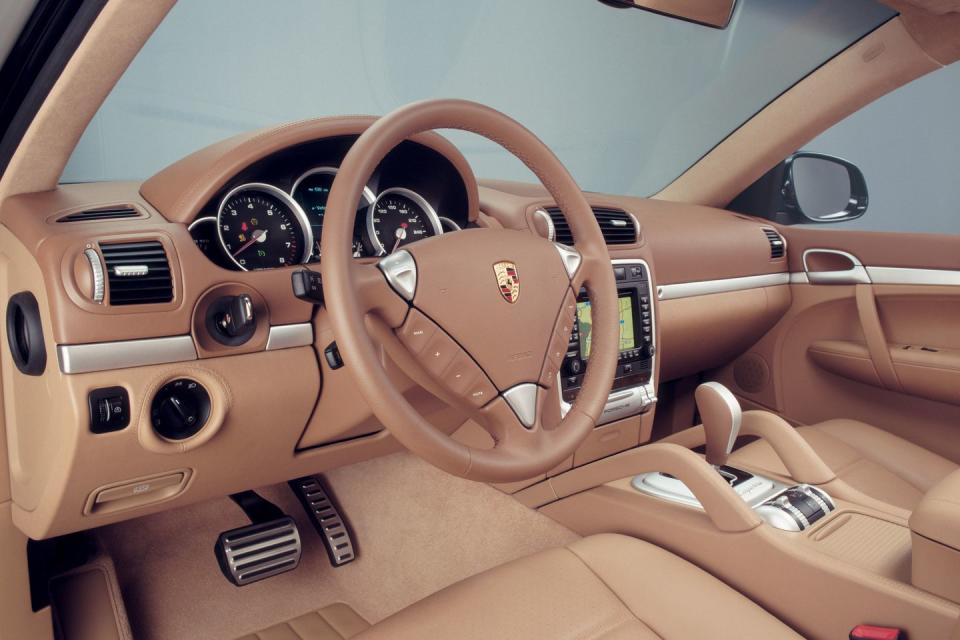
An Aisin-supplied six-speed automatic transmission with Tiptronic override converts engine speed to driveshaft rotation with shaved-leg smoothness. Downstream of that is a planetary center differential that normally sends 62 percent of the torque to the rear wheels, but using a multiplate clutch, the Porsche Traction Management system can shunt up to 100 percent of engine torque to whichever axle needs it.
Around-town driving is supremely civilized, with finely modulated throttle tip-in and stop-and-go manners. But when you summon the full 8.7 psi of turbo pressure to pass on a country road— Oy vay!—the Tiptronic executes a nifty double kickdown and the vehicle squirts like hot Cheez Whiz. In the time it takes to swallow hard, the Cayenne Turbo is well into civil-aviation speeds.
Wow. Imagine what it would be like if it weighed 1000 pounds less!
If you are so bourgeois as to consider the tedious value formula, the smash-mouth Turbo we tested cost $94,980 (with optional niceties such as a sunroof, a CD changer, and keyless entry). The Cayenne S—the non-turbocharged version propelled by a relatively noodle-armed 340 horsepower and 310 lb-ft—starts at $56,665 and can be optioned to more than $80,000.
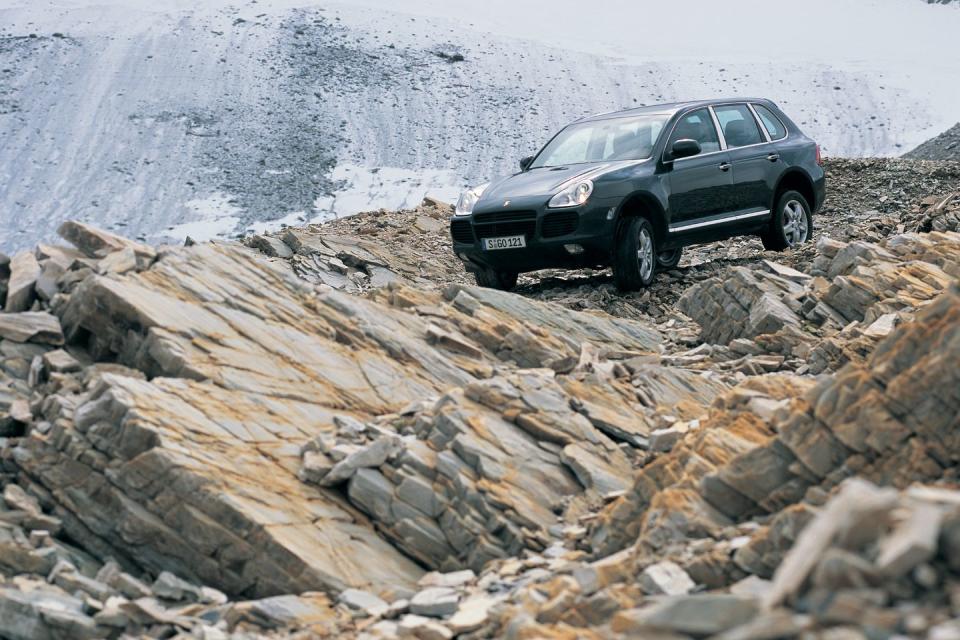
As you might expect, it takes an extraordinary exertion of technology to achieve excellent handling with this much mass while still retaining ride comfort. The suspension is a Byzantine hybrid of control arms attached to tubular and plate steel subframes, with all four corners sitting on air springs assisted by adaptive dampers that can be set in Comfort, Normal, and Sport modes. Vehicle ride height lowers as speeds increase (a full 1.5 inches lower than normal at speeds above 130 mph), and the damper stiffness defaults to Sport mode if the vehicle's accelerometers detect more than the usual thrashing about. Porsche Stability Management wrangles the anti-lock-brake, brake-force-distribution, ride-leveling, and all-wheel-drive traction-control systems to keep the Cayenne upright and on course. As a result of these interventions, the Cayenne's dynamics have a peculiar, synthetic feel to them; it sometimes feels as if the faster you go in the Cayenne, the flatter it corners.
Yet with the damper control set on Sport and the ride height on low, the Cayenne arcs around a highway on-ramp with a nice, edgy tautness. The rear end does an ever-so-slight hip shift on initial turn-in, characteristic of recent Porsches, and then hunkers down in a composed four-wheel drift. If the ramp tightens and you need to get out of the throttle, it's okay. The Cayenne, like the 911, does only the slightest wiggle before the rear toe-in tightens up and the tail tucks in.
Yet for all the sensors, processors, adaptive kinematics, and the like—to say nothing of the optional 19-inch Pirelli P Zero Rosso summer tires—the Cayenne generates only decent cornering grip, 0.82 g on the skidpad, a number handily exceeded by an Infiniti FX45, for one. Shove the vehicle around, and you'll soon wish you had more tire under you. The feeling is a little like driving on bias-ply tires.
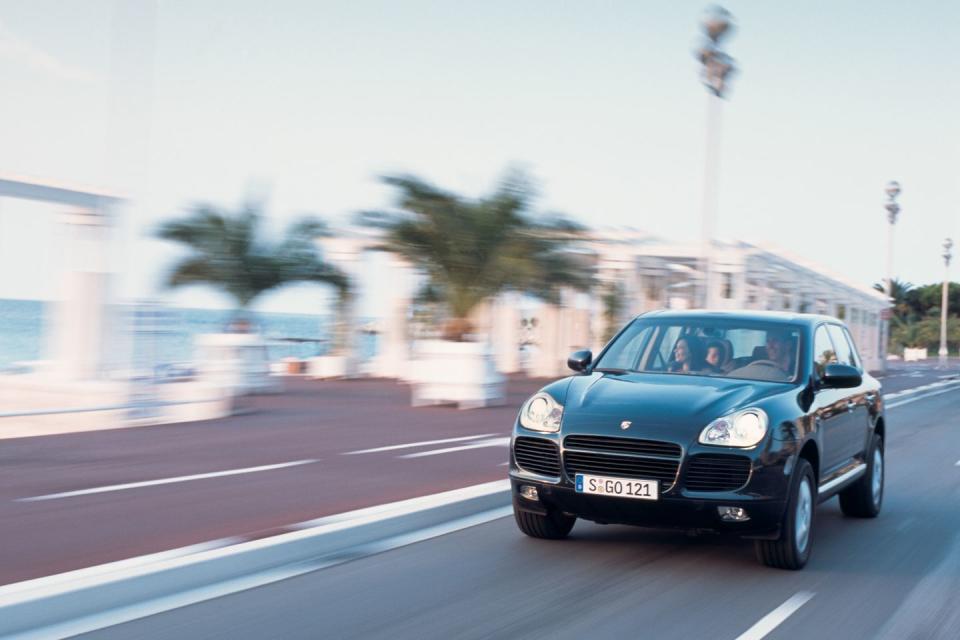
The Cayenne's weight dampens our enthusiasm in other ways. The braking distance from 70 mph, 170 feet, is six feet longer than that of a BMW X5 4.6is—this despite the fact the Cayenne has six-piston front calipers and gigantic vented discs. And according to fearless leader Tony Swan, this same sport-ute's brakes got a little squishy during his intrepid One Lap of America flog-fest. How very un-Porsche-like.
Make no mistake: The Cayenne Turbo is an extraordinary machine, beautifully crafted, sumptuously provisioned, modestly— ahem—styled. It is the fastest production SUV on the planet, and it has more off-road chops than Sir Edmund Hillary. It's sure to be a huge status codpiece in South Beach and Beverly Hills. It is the "Porsche of SUVs." We had hoped for a little more Porsche and a little less SUV.
Counterpoints
After exercising this rig on a number of road-racing circuits during the 2003 One Lap of America run, I can confidently say the Cayenne is a lovely highway ride. I can say even more confidently that it is not at home on a racetrack, particularly one with lots of linked turns and decreasing radii. We are talking dynamic reluctance on a vast scale here. A goal was to give it Porsche-sports-car virtues to go with its superb off-road capabilities. But that just ain't compatible with a vehicle weighing almost three tons. I suppose you can teach an elephant to be a sprinter, but why not start with a gazelle? —Tony Swan

Listen up, all you nouveau-riche rappers and cash-phat NBA power forwards who are right now trading in your G-wagens for this even-more-expensive super-status symbol: You can get stuck in the mud in this wundertruck very easily with these Pirellis, which are designed for the highway. That happened in rural Michigan last spring, when one of us decided to drive through a farmer's soggy field. The expensive 19-inch P Zeros sank right up to the hubs. It was a plain ol' pickup truck that pulled this 450-hp technological marvel from the muck. Reminds us of all the SUV owners we saw in ditches last winter who thought their SUVs made them invincible. —Steve Spence
It's hard to believe a vehicle this heavy can be thrust forward this quickly with a mere 450 turbocharged horsepower, but the numbers don't lie. The Cayenne is seriously quick, and capable of 161 mph, which puts it in a category all by itself. It's also a demon off-road, as I found out during the course of running in the Cayenne Crossing Drive for Hope, a cross-country charity run using two-lane and no-lane roads on a 2700-mile course. On the Peter's Mill trail in northern Virginia, the Cayenne Turbo just reared back and laughed at the rocky terrain, lifted itself up off the suspension, and handily went through eight miles of pure hell. —Jim McCraw
You Might Also Like

 Yahoo News
Yahoo News 
